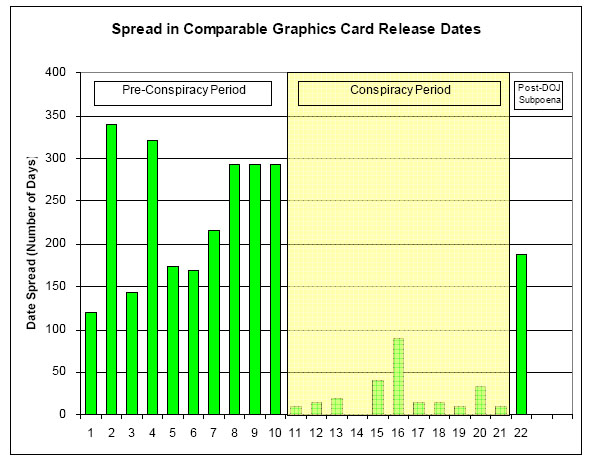Oh snap! Sorry G, I was talking about
a PDF you can pick up
from this thread over at Tech Power Up.
Be warned, the thread I linked to is a stereotypical example of how the internets can make you stupid.

Again my apologies, I'm usually better about references....this dog watching gig has got me all messed up.

These are the graphs I'm talking about btw:
1. Riva128 ($199, 9/1997) & 3D Rage II ($149,
1/12/1998)
2. Riva TNT 16MB ($170, 3/23/1998) & Rage
Fury ($229, 2/26/1999)
3. Riva TNT2 Ultra ($230, 3/15/1999) & Rage
Fury Pro ($149, 8/5/1999)
4. GeForce256 DDR ($300, 8/31/1999) &
Radeon DDR ($399, 7/17/2000)
5. GeForce2 MX400 ($115, 3/6/2001) &
Radeon 7500 ($199, 8/27/2001)
6. GeForce3 ($499, 2/27/2001) & Radeon
8500 ($399, 8/14/2001)
7. GeForce4 Ti4400 ($267, 3/18/2002) &
Radeon 8500 ($399, 8/14/2001)
8. GeForce3 Ti500 128MB ($399, 10/1/2001)
& Radeon 9000 Pro 128MB ($149,
7/22/2002)
9. GeForce3 Ti500 64MB ($349, 10/1/2001) &
Radeon 9000 Pro 64MB ($129, 7/22/2002)
10. GeForce3 Ti200 ($199, 10/1/2001) &
Radeon 9000 ($109, 7/22/2002)
11. GeForce FX 5800 ($399, 5/2003) & Radeon
9800 ($399, 5/5/2003)
12. GeForce 5600 ($200, 4/2003) & Radeon 9600
($200, 4/2003)
13. GeForce 6800 Ultra ($499, 4/14/2004) & Radeon
X800 XT PE ($499, 5/4/2004)
14. GeForce 6800 GT ($399, 5/4/2004) & Radeon
X800 Pro ($399, 5/4/2004)
15. GeForce 6600 GT ($199, 8/12/2004) & Radeon
X600 XT ($199, 9/21/2004)
16. GeForce 6200 GT ($140, 7/2005) & Radeon
9550 ($140, 4/2005)
17. GeForce 6800 GT ($299, 9/2005) & Radeon
X800 XL CrossFire ($299, 9/2005)
18. GeForce 6800 ($199, 9/2005) & Radeon X800
CrossFire ($199, 9/2005)
19. GeForce 7600GT 256MB ($175, 5/5/2006) &
Radeon X1600 256MB ($175, 4/24/2006)
20. GeForce 7950 GT ($269.99, 9/14/2006) &
Radeon X1950 Pro ($269.99, 10/17/2006)
21. GeForce 7900 GS ($200, 9/6/2006) & Radeon
X1650 Pro ($199, 9/15/2006)
22. GeForce 8800 GTX ($599, 11/8/2006) & Radeon
HD 2900 XT ($399, 5/14/2007)
1. Riva128 ($199, 9/1997) & 3D Rage II ($149,
1/12/1998)
2. Riva TNT 16MB ($170, 3/23/1998) & Rage
Fury ($229, 2/26/1999)
3. Riva TNT2 Ultra ($230, 3/15/1999) & Rage
Fury Pro ($149, 8/5/1999)
4. GeForce256 DDR ($300, 8/31/1999) &
Radeon DDR ($399, 7/17/2000)
5. GeForce2 MX400 ($115, 3/6/2001) &
Radeon 7500 ($199, 8/27/2001)
6. GeForce3 ($499, 2/27/2001) & Radeon
8500 ($399, 8/14/2001)
7. GeForce4 Ti4400 ($267, 3/18/2002) &
Radeon 8500 ($399, 8/14/2001)
8. GeForce3 Ti500 128MB ($399, 10/1/2001)
& Radeon 9000 Pro 128MB ($149,
7/22/2002)
9. GeForce3 Ti500 64MB ($349, 10/1/2001) &
Radeon 9000 Pro 64MB ($129, 7/22/2002)
10. GeForce3 Ti200 ($199, 10/1/2001) &
Radeon 9000 ($109, 7/22/2002)
11. GeForce FX 5800 ($399, 5/2003) & Radeon
9800 ($399, 5/5/2003)
12. GeForce 5600 ($200, 4/2003) & Radeon 9600
($200, 4/2003)
13. GeForce 6800 Ultra ($499, 4/14/2004) & Radeon
X800 XT PE ($499, 5/4/2004)
14. GeForce 6800 GT ($399, 5/4/2004) & Radeon
X800 Pro ($399, 5/4/2004)
15. GeForce 6600 GT ($199, 8/12/2004) & Radeon
X600 XT ($199, 9/21/2004)
16. GeForce 6200 GT ($140, 7/2005) & Radeon
9550 ($140, 4/2005)
17. GeForce 6800 GT ($299, 9/2005) & Radeon
X800 XL CrossFire ($299, 9/2005)
18. GeForce 6800 ($199, 9/2005) & Radeon X800
CrossFire ($199, 9/2005)
19. GeForce 7600GT 256MB ($175, 5/5/2006) &
Radeon X1600 256MB ($175, 4/24/2006)
20. GeForce 7950 GT ($269.99, 9/14/2006) &
Radeon X1950 Pro ($269.99, 10/17/2006)
21. GeForce 7900 GS ($200, 9/6/2006) & Radeon
X1650 Pro ($199, 9/15/2006)
22. GeForce 8800 GTX ($599, 11/8/2006) & Radeon
HD 2900 XT ($399, 5/14/2007)
Apology for the formatting of the card infos, but I got 'em off page 15 & 16 of the PDF and I'm lazy about formatting at 3:30am. I just found some of their card match-ups ridiculous.


